 |
Charles Ives (1874 – 1954) is often hailed as America's greatest composer of serious music.  Yet, America's contributions to classical music are largely derivative and eclipsed by our gifts to jazz, blues, country, pop and, of course, good old rock and roll. In terms of our overall culture, Ives may not have been more important than Louis Armstrong, Robert Johnson, Hank Williams, George Gershwin or Chuck Berry, but he surely was the quintessential American composer. Like America itself, Ives was an amalgam of our traditional roots and far-reaching vision, and brimmed with all our contradictions and complexity. His music bursts at every seam with the idiom of America. Yet, America's contributions to classical music are largely derivative and eclipsed by our gifts to jazz, blues, country, pop and, of course, good old rock and roll. In terms of our overall culture, Ives may not have been more important than Louis Armstrong, Robert Johnson, Hank Williams, George Gershwin or Chuck Berry, but he surely was the quintessential American composer. Like America itself, Ives was an amalgam of our traditional roots and far-reaching vision, and brimmed with all our contradictions and complexity. His music bursts at every seam with the idiom of America.
 Ives was born and raised in Connecticut. He was imbued with the New England Transcendentalists' belief in nature, self-reliance and a basic faith in both the common man and himself. His musical horizons were stretched by his father George, the leader of the Danbury village band, who loved to experiment with acoustics (exploring the sound of instruments in various natural settings), counterpoint (playing melody and harmony in different keys),
Ives was born and raised in Connecticut. He was imbued with the New England Transcendentalists' belief in nature, self-reliance and a basic faith in both the common man and himself. His musical horizons were stretched by his father George, the leader of the Danbury village band, who loved to experiment with acoustics (exploring the sound of instruments in various natural settings), counterpoint (playing melody and harmony in different keys),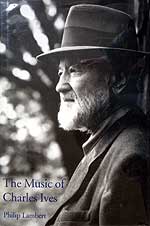 dissonance (constructing a machine to divide octaves into microtones) and happenstance (arranging for bands playing different songs to pass each other in parades). The clash of old and new would come to permeate Ives's music, which confidently tosses together everyday elements in bizarre extremes. dissonance (constructing a machine to divide octaves into microtones) and happenstance (arranging for bands playing different songs to pass each other in parades). The clash of old and new would come to permeate Ives's music, which confidently tosses together everyday elements in bizarre extremes.
Ives was a man of deep philosophical conviction, always insisting on doing things his way. But upon graduating from Yale, he faced a dilemma – he refused to compromise his principles to compose trendy, attractive music that would earn a living; yet, as he put it, he couldn't let his children starve on his dissonances. His solution was a hard but practical one – he relegated art to the sidelines and devoted himself to the world of business. Beginning as an actuarial clerk, Ives worked his way up in the life insurance industry with phenomenal success. Co-founder of an agency that grew to become the largest in the country, by middle age Ives could have retired a multi-millionaire (back when that really meant something). 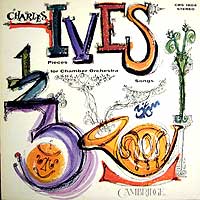 But Ives stayed true to his roots by living humbly and striving to tailor life insurance to the needs of the working man. For decades, he was known as the innovator of estate planning and sales training. Colleagues often were surprised to learn that he also wrote music. But Ives stayed true to his roots by living humbly and striving to tailor life insurance to the needs of the working man. For decades, he was known as the innovator of estate planning and sales training. Colleagues often were surprised to learn that he also wrote music.
Ives consigned his musical career, such as it was, to evenings and weekends, during which he compiled a striking portfolio of far-fetched compositions whose polyphony, microtones, sprawling structures and wildly complex tonality and rhythms anticipated by decades much of what we now have come to consider the leading edge of twentieth century music. He bridled at convention and fought the most basic cultural assumptions: "What has sound got to do with music? … Why can't music go out in the same way it comes in to a man, without having to crawl over a fence of sounds, thoraxes, catguts, wire, wood and brass? ... The instrument – there is the perennial difficulty … . Is it the composer's fault that man has only ten fingers? ... That music must be heard is not essential – what it sounds like may not be what it is." And then, around 1920, just as he reached his early forties and could have begun to focus attention on attracting an indifferent world's notice to his art, Ives' health faltered. Although his life was barely half over, he became increasingly withdrawn. He ignored the musical establishment, which gladly repaid the favor. He remained one of America's best-kept secrets.
Ives did little to ease his artistic seclusion. He avoided contacts that could have led to recognition, feeling that he would "work better if I kept to my own music and let other people keep to theirs." He believed that good music had to be noncommercial, envisioning the birth of true talent "when the last man who is willing to make a living out of art is gone and gone forever." He rarely sought performances, asserting that "the more a composer accepts from his patron, the less he will accept from himself." He refused to copyright his music, insisting that anyone be able to use it, and scared off publishers by demanding that they make free copies available upon request. He issued two works on his own – his "Concord" Piano Sonata and a collection of songs – entirely at his own expense and gave away the copies.
 Ives's music reflects the central paradox that shaped his upbringing. On the one hand, he was an ardent populist, with unwavering faith in the common man. He mused that even Beethoven's art (which he considered "the best product that human beings can boast of") might be "as nothing in comparison with the future product of some coal-miner's soul in the forty-first century." He urged critics, stuck in a conventional mind-set of constant repetitions of art music to "go into some other line of business for a year or so" so that their "perspective would be more naturally normal" and chided that "If for every thousand-dollar prize a potato field be substituted, so that these candidates of Clio can dig a little in real life, perhaps dig up a natural inspiration, art's air might be a little clearer." Thus, Ives unabashedly "borrowed" his themes from (then) well-known hymns, marches, classics and songs, and showed his respect for the taste and spirit of the masses by replicating untutored singing through "wrong" notes, faltering rhythms and clusters of tones that surrounded, and often smothered, conventional melody.
Ives's music reflects the central paradox that shaped his upbringing. On the one hand, he was an ardent populist, with unwavering faith in the common man. He mused that even Beethoven's art (which he considered "the best product that human beings can boast of") might be "as nothing in comparison with the future product of some coal-miner's soul in the forty-first century." He urged critics, stuck in a conventional mind-set of constant repetitions of art music to "go into some other line of business for a year or so" so that their "perspective would be more naturally normal" and chided that "If for every thousand-dollar prize a potato field be substituted, so that these candidates of Clio can dig a little in real life, perhaps dig up a natural inspiration, art's air might be a little clearer." Thus, Ives unabashedly "borrowed" his themes from (then) well-known hymns, marches, classics and songs, and showed his respect for the taste and spirit of the masses by replicating untutored singing through "wrong" notes, faltering rhythms and clusters of tones that surrounded, and often smothered, conventional melody.
Yet, his music was far removed from popular taste and had little appeal to the masses. Much of it is astoundingly complex and brutally difficult to perform. Ives disdained conventional music for its repetitious form and the inefficiency of so many musicians playing the same notes.
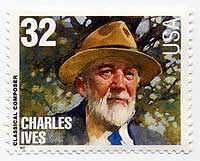
Ives arrives – his very own stamp! |
("If [a] work perhaps had one hundred and fifty valuable ideas, the one hundred and fifty men [in an orchestra] might be justifiable, but as it probably contains not more than a dozen, the composer may be unconsciously ashamed of them, and glad to cover them up under a hundred and fifty men.") He took as a compliment criticism that his works were too dense and crammed with overlapping fragments of ideas thrown together in a seemingly chaotic stream-of-consciousness. Indeed, Ives readily admitted that some of his music was unplayable and even relished the thought, at one point defending an unsingable song's right to exist: "If it feels like kicking over an ash can, a poet's castle, or a prosodic law, will you stop it? … If it happens to feel like trying to fly where humans cannot fly, to sing what cannot be sung, to walk in a cave on all fours, or to tighten up its girth in blind hope and faith and try to scale mountains that are not, who shall stop it? In short, must a song always be a song!" He had no tolerance for pretty, soothing sounds (he especially scorned Mozart for having emasculated music) and derided as "Rollos" and "Ladybirds" those who doted on conventional notions of beauty and couldn't stand dissonance. At a 1929 concert of Charles Ruggles's thorny Men and Mountains, Ives reportedly shouted down a catcaller by yelling: "Stop being such a God-damned sissy! Why can't you stand up before fine strong music like this and use your ears like a man?"
Perhaps the key to understanding Ives lies in the character of America itself – his music is a reflection of our great melting pot society that embraces shards of a wide variety of disparate cultures, and manages to produce a result that emerges as something altogether new, exciting and cohesive, yet in a way vaguely familiar. As for its challenges, John Kirkpatrick wrote upon returning from Ives's funeral: "In retrospect … it seemed clearer to me than ever before that Charlie was probably here for a purpose, that the complacent patterns had to be upset."
 Of Ives' four numbered symphonies, the first three provide scant preparation for the astounding breadth of his Fourth, even though two of them paved the way to his current esteem.
Of Ives' four numbered symphonies, the first three provide scant preparation for the astounding breadth of his Fourth, even though two of them paved the way to his current esteem.
 Ives's First Symphony was written at Yale – the first movement as a freshman and the rest for his senior thesis.
Ives's First Symphony was written at Yale – the first movement as a freshman and the rest for his senior thesis. 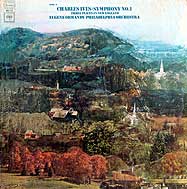 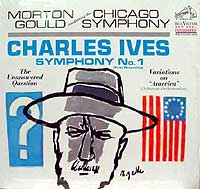 Mincing few words, he later called it "if not the worst [then] one of the worst, … poorest, weakest things I've ever written. … It was written for a degree – that is, to complete my four years academic course at Yale. … The better and more exactly you imitate the Joneses, the surer you are to get a degree." Heard today, it's an attractive but largely derivative work, much of which could easily pass for early Tchaikovsky, with a haunting opening theme, a second movement with the sonority and structure, but not the memorable hymn-like tune, of Dvorak's then-new "New World" Symphony, and a marvelously playful fugal scherzo surrounding a gracious, balletic trio, none of which seems unduly mired in academic rote. Despite its purpose, Ives did manage to have some fun, especially in the first movement, which meanders through a wide-ranging harmonic journey (he once remarked that since there is no rule requiring people to die in the same place they were born, music should not have to end in the same key in which it began), and in the finale, which piles up multiple codas before finally ending. Overall, it treads a very thin line between facetious mockery of the European models American composers were expected to emulate and genuine talent in a late 19th century idiom. Ives was loath to admit the valuable grounding he received in traditional music at Yale from Horatio Parker, his eminent but conservative music professor, and their relationship never rose above mutual toleration. Indeed, Ives managed only a low B in his music courses (although his music grades were better than his others, which were barely passing). The First Symphony received its first performance in 1953 (by Richard Bales and the National Gallery Orchestra), and its first recording in 1966 (by Morton Gould and the Chicago Symphony on RCA, whose forthright vigor still sounds wonderful) and a second, more mellow reading in 1968 by Eugene Ormandy and the Philadelphia Orchestra (on Columbia). Mincing few words, he later called it "if not the worst [then] one of the worst, … poorest, weakest things I've ever written. … It was written for a degree – that is, to complete my four years academic course at Yale. … The better and more exactly you imitate the Joneses, the surer you are to get a degree." Heard today, it's an attractive but largely derivative work, much of which could easily pass for early Tchaikovsky, with a haunting opening theme, a second movement with the sonority and structure, but not the memorable hymn-like tune, of Dvorak's then-new "New World" Symphony, and a marvelously playful fugal scherzo surrounding a gracious, balletic trio, none of which seems unduly mired in academic rote. Despite its purpose, Ives did manage to have some fun, especially in the first movement, which meanders through a wide-ranging harmonic journey (he once remarked that since there is no rule requiring people to die in the same place they were born, music should not have to end in the same key in which it began), and in the finale, which piles up multiple codas before finally ending. Overall, it treads a very thin line between facetious mockery of the European models American composers were expected to emulate and genuine talent in a late 19th century idiom. Ives was loath to admit the valuable grounding he received in traditional music at Yale from Horatio Parker, his eminent but conservative music professor, and their relationship never rose above mutual toleration. Indeed, Ives managed only a low B in his music courses (although his music grades were better than his others, which were barely passing). The First Symphony received its first performance in 1953 (by Richard Bales and the National Gallery Orchestra), and its first recording in 1966 (by Morton Gould and the Chicago Symphony on RCA, whose forthright vigor still sounds wonderful) and a second, more mellow reading in 1968 by Eugene Ormandy and the Philadelphia Orchestra (on Columbia).
 On February 22, 1951 occurred one of the most important concerts in American history, doing as much for the cause of American classical music as Benny Goodman's seminal 1938 concert (also in Carnegie Hall) had done to legitimize jazz. In between the comfortable first half devoted to Mozart and a finale of Copland's sure-fire El Salón México Leonard Bernstein led the world premiere of Ives's Symphony # 2, a full half-century after its completion. Bernstein had offered a private performance to the composer, who declined and avoided the concert as well. (Mrs. Ives, just as stubborn a Yankee, did attend and seemed genuinely surprised, after decades of neglect and scorn of her husband's music, that the audience actually liked it.)
On February 22, 1951 occurred one of the most important concerts in American history, doing as much for the cause of American classical music as Benny Goodman's seminal 1938 concert (also in Carnegie Hall) had done to legitimize jazz. In between the comfortable first half devoted to Mozart and a finale of Copland's sure-fire El Salón México Leonard Bernstein led the world premiere of Ives's Symphony # 2, a full half-century after its completion. Bernstein had offered a private performance to the composer, who declined and avoided the concert as well. (Mrs. Ives, just as stubborn a Yankee, did attend and seemed genuinely surprised, after decades of neglect and scorn of her husband's music, that the audience actually liked it.) 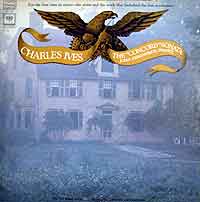 Ives reportedly heard a broadcast of the concert the following week on his maid's radio and was thrilled. When he died three years later, he could not have suspected the massive tide of discovery and admiration of his work that had just begun to build and that would culminate in nothing less than a crucial reevaluation and understanding of America's contribution to serious music. Ives reportedly heard a broadcast of the concert the following week on his maid's radio and was thrilled. When he died three years later, he could not have suspected the massive tide of discovery and admiration of his work that had just begun to build and that would culminate in nothing less than a crucial reevaluation and understanding of America's contribution to serious music.
The Bernstein inferno did not arise in a vacuum. There had been some earlier sparks, peaking with a January 20, 1939 performance in New York's Town Hall of Ives's massive "Concord" Piano Sonata, which John Kirkpatrick mastered only after years of devoted struggle. In an ecstatic New York Herald Tribune review, Lawrence Gilman called Ives "probably the most original and extraordinary of American composers" and the Sonata
exceptionally great music – it is, indeed, the greatest music composed by an American, and the most deeply and essentially American in impulse and implication. It is wide-ranging and capacious. It has passion, tenderness, humor, simplicity, homeliness. It has imaginative and spiritual vastness. It has wisdom, beauty and profundity, and a sense of the encompassing terror and splendor of human life and human destiny – a sense of those mysteries that are both human and divine … a quality of musical utterance which is altogether extraordinary and unique, … pages in which the expressional power of music is mysteriously extended and released.
Yet, other musical sophisticates were less impressed. Elliott Carter, a former Ives protégé who later would become the dean of American composers, slammed the Concord as "trivial," with "a lack of logic which repeated hearings can never clarify. … The esthetic is naïve, often too naïve to express serious thoughts."
But the Ives cavalcade only began to pick up critical mass with the Bernstein concert, of which the reviews were largely elated in praise of its sheer American character. Thus, Olin Downes in the New York Times called it "astonishing … by turns rudely, tenderly, fantastically and cantankerously Yankee." Virgil Thomson in the Herald Tribune proclaimed it "unquestionably an authentic work of art" that "speaks of American life with love and humor and deep faith." Robert Savin in Musical America dubbed it "utterly sincere … a wholesome and natural expression of American life … ." But Henry Cowell cautioned that it "contains only in the most embryonic state the unique outpouring of dissonance, polyharmonies, polyrhythms, etc. for which Ives has become especially known" and attributed audience plaudits to having "braced themselves to hear unbearable dissonances" but instead found themselves relieved by "a grand bagful of tunes in a familiar idiom." 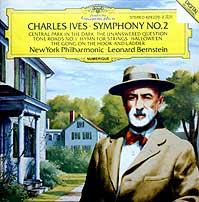 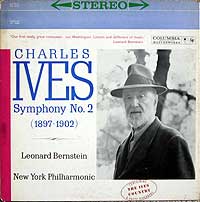 More recently, Frank Rossiter agreed: "Much of the public and even critical reaction to Bernstein's performance of the Second Symphony was out of all proportion to the merit of a work that was not only dated and derivative in its 19th century European romanticism but also far less interesting than many of Ives's later orchestral compositions. It was as if Ives were being belatedly compensated for the long neglect of his more daring work." A more benign vindication of its appeal might lie in its evocation of an idealized, simpler America gladly embraced by audiences still recovering from the Second World War. More recently, Frank Rossiter agreed: "Much of the public and even critical reaction to Bernstein's performance of the Second Symphony was out of all proportion to the merit of a work that was not only dated and derivative in its 19th century European romanticism but also far less interesting than many of Ives's later orchestral compositions. It was as if Ives were being belatedly compensated for the long neglect of his more daring work." A more benign vindication of its appeal might lie in its evocation of an idealized, simpler America gladly embraced by audiences still recovering from the Second World War.
Indeed, the Second Symphony is barely more challenging than the First, although in place of wholly original, if imitative, themes, it relies heavily on Ives's trademark "borrowings" – interweaving snatches of familiar hymns, marches and pop standards (30 in the second movement alone), as well as adaptations of his own earlier work (here, two organ pieces), into established symphonic forms and orchestration. Burkholder observes that "if the First Symphony pays homage to the European symphonic tradition, the Second celebrates both European and American music and points out what is most characteristic of each" – transitional passages and episodes from overseas and home-grown elements of paraphrased tunes and sheer rough-hewn character. Bernstein reconciles the sheer scope of quotations, from Bach to "Turkey in the Straw," as "a personal memoir of Ives's own musical experience."
Perhaps its most extraordinary touch, and one which electrifies audiences and is guaranteed to draw a laugh, is the startling ending, in which tubas belch out two seconds of "Columbia, Gem of the Ocean," cut off by trumpets blaring two seconds of "Reveille," and then a sharp, dissonant tutti chord, all played fff. Yet, in his 1939 critique of the Concord concert, Carter raised a troubling spectre: "[Ives] has rewritten his works so many times, adding dissonances and polyrhythms, that it is probably impossible to tell at what date the works assumed their surprising form we now know." He later recalled that while Ives was preparing Three Places in New England for a 1929 performance: "A new score was being derived from the older one to which he was adding and changing, turning octaves into sevenths and ninths and adding dissonant notes." Indeed, in her 2008 Ives Reconsidered, Gayle Sherwood Magee reproduces the final pages of four evolving versions of the Second Symphony to show that it originally had been written with a thoroughly tonal F-Major cadence, then revised in the 1930s to add the snatch of "Columbia," and then changed yet again to its final form prior to the Bernstein premiere, thus suggesting that, in keeping with his emerging image as a cultural hero, Ives recast himself as far more radical than he really had been at the time. (Magee speculates that the final version of the ending, thoroughly incongruous with the rest, was crafted by Cowell, for whom cluster chords were a musical signature.) (We should note that questions also have been raised as to the chronology of the Ives Fourth Symphony – although Ives claimed that the work was completed by 1916, Jan Swafford found that portions were derived from a 1923 source and suggests that Ives, frankly, lied in order to conceal from his business partner how much time he was spending away from the office continuing to compose – and to sustain the illusion of sacrificing his art to his family responsibilities.)
Bernstein's repetition of the concert on the following Sunday was recorded and preserved on a single surviving Voice of America copy archived in the Library of Congress. Released in 2000 by the New York Philharmonic on a super-premium Bernstein Live box set, it's fleet, casual, pastoral and refreshing, without even a hint of self-importance, yet just a bit tentative. A 1958 studio recording – one of Bernstein's first as permanent conductor of the Philharmonic – is more confident, alive with vigor and detail (although it was not the work's first recording – in the interim an LP had appeared on the SPA label featuring a thoroughly competent performance by F. Charles Adler and the Vienna Philharmonic that rises to a middle movement that manages to blend delicacy with power but then subsides to a sluggish and severe finale relieved only by occasional touches of grace). A live 1987 Bernstein/Philharmonic DG remake is smoother, richer and (gasp!) even rather Romantic. Interestingly, Mrs. Ives included in a letter of appreciation her husband's comment that Bernstein had taken the allegros too slowly, but he seems to have barely heeded that advice – his second movement timings contracted from 10:57 in 1951 to 10:21 in 1958 but then rebounded to 11:06 in 1987, while the finale kept expanding from 8:27 in '51 to 9:13 in '58 and 10:05 in '87. (I blanch at what Ives would have thought of the bloated 1973 Ormandy/Philadelphia timings of 13:22 and 10:26!)
 Even before Bernstein's imprimatur propelled Ives into public esteem, Ives's 1904 Third Symphony marked his arrival in the pantheon of the music community's recognition when it was awarded the 1947 Pulitzer prize, having come to the committee's attention after its world premiere in a 1946 League of Composers concert led by Lou Harrison (in which the work was played twice). Typically, Ives snubbed the honor as a "badge of mediocrity" ("Prizes are for boys. I'm grown up."), refused to attend the award ceremony, declined interviews and gave away the $500.
Even before Bernstein's imprimatur propelled Ives into public esteem, Ives's 1904 Third Symphony marked his arrival in the pantheon of the music community's recognition when it was awarded the 1947 Pulitzer prize, having come to the committee's attention after its world premiere in a 1946 League of Composers concert led by Lou Harrison (in which the work was played twice). Typically, Ives snubbed the honor as a "badge of mediocrity" ("Prizes are for boys. I'm grown up."), refused to attend the award ceremony, declined interviews and gave away the $500. 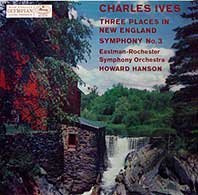 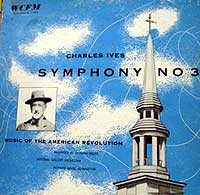 Yet the attention led to a performance by the Boston Symphony in February 1948 – the very first of an Ives work by a major orchestra (albeit led by its associate conductor Richard Burgin rather than its music director Serge Koussevitzky, a champion of modern American music), and thus perhaps smoothed the path for Bernstein. Its first recording followed in 1950 with a rather attentive but literal reading by Richard Bales and the National Gallery Orchestra on WCFM Records, aptly paired with a suite of American colonial music. (Curiously, both the original 1947 and revised 1965 editions of the score specify performance times of 17 minutes, which seems far too rushed; Bales takes a more sensible 22½, just about midway between the fastest (Hanson, 21) and slowest (Bernstein, 25) that I've encountered on record.) Yet the attention led to a performance by the Boston Symphony in February 1948 – the very first of an Ives work by a major orchestra (albeit led by its associate conductor Richard Burgin rather than its music director Serge Koussevitzky, a champion of modern American music), and thus perhaps smoothed the path for Bernstein. Its first recording followed in 1950 with a rather attentive but literal reading by Richard Bales and the National Gallery Orchestra on WCFM Records, aptly paired with a suite of American colonial music. (Curiously, both the original 1947 and revised 1965 editions of the score specify performance times of 17 minutes, which seems far too rushed; Bales takes a more sensible 22½, just about midway between the fastest (Hanson, 21) and slowest (Bernstein, 25) that I've encountered on record.)
Drawing from earlier organ pieces (now lost), and quoting only hymns, Ives wrote his Third Symphony, entitled "The Camp Meeting," for a small orchestra (flute, oboe, clarinet, bassoon, two horns and strings) plus bells, which are heard in the last two measures – but only barely, as they enter ppp and trail off to ppppp. In a note to the 1965 edition of the score, Cowell noted that the part appears only as a faint outline in the manuscript and suggested that Ives really sought the sound of distant church bells without any particular rhythm or pitch – just a few tones coming in and out, which could be recorded and played off-stage. Although a sketch for a rejected fourth movement was to have begun with simultaneous lines in 8/4, 6/4 and 7/4, the final version of the Third has the most conservative sound of all Ives's major works. Yet, it did introduce a remarkable technique, which Peter Burkholder dubbed "cumulative form" – instead of beginning with a theme and then varying and developing it as a movement progresses, as in traditional European formal structures, Ives reverses that process by beginning with fragments, paraphrases and variations, often in a vague or unstable key, that eventually coalesce into the theme. Thus, the theme becomes the goal of development, rather than serving as its genesis. Here, the technique seems intimately bound to the narrative allusions of the first and third movements, which Ives labeled "Old Folks Gatherin'" and "Communion," as the emergence of the theme from disparate shards serves to depict a coming together first of people and then of their faith. Another Ives hallmark technique displayed here is that of "shadow parts," in which hushed continuous lines emerge and can be perceived only occasionally from beneath the overall texture, and often linger to form a haunting conclusion after the rest of the ensemble finishes.
An intriguing "might have been" – by sheer coincidence, in early 1911 Gustav Mahler saw the score of the Ives Third Symphony while at the Tams Copying Service office in New York and was so enthused that he asked for a copy to take back to Europe. Alas, he died that summer. We can only wonder about the impact upon Ives's career (and American music generally) had one of the world's most influential conductors performed and campaigned for Ives nearly a half-century before the rest of the world would catch up.
 Ives produced one further symphony before his Fourth, although it was not given a number and Ives directed that the movements could be played separately, as they often are. Indeed, Ives boasted that the four movements ("Washington's Birthday," "Decoration Day," "The Fourth of July" and "Thanksgiving and Forefathers' Day") had no special musical connection and that traditionalists would be frustrated trying to find common elements that would be expected to link the movements of a conventional symphony.
Ives produced one further symphony before his Fourth, although it was not given a number and Ives directed that the movements could be played separately, as they often are. Indeed, Ives boasted that the four movements ("Washington's Birthday," "Decoration Day," "The Fourth of July" and "Thanksgiving and Forefathers' Day") had no special musical connection and that traditionalists would be frustrated trying to find common elements that would be expected to link the movements of a conventional symphony. 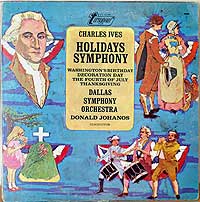 Rather, their connection is purely programmatic, each movement, according to Ives, presenting pictures of a boy's seasonal American holidays in a country town (or, as J. Peter Burkholder notes, more accurately depicting a middle-aged man remembering – and idealizing – the celebrations of his boyhood), including a barn dance, a parade with multiple marching bands, fireworks and a respectful visit to the local cemetery. Rather, their connection is purely programmatic, each movement, according to Ives, presenting pictures of a boy's seasonal American holidays in a country town (or, as J. Peter Burkholder notes, more accurately depicting a middle-aged man remembering – and idealizing – the celebrations of his boyhood), including a barn dance, a parade with multiple marching bands, fireworks and a respectful visit to the local cemetery.
Despite his principles, Ives was never one for consistency. Thus, with the Holidays Symphony we encounter another of the many Ives paradoxes to join the list compiled by Jan Swafford (writing modern music while obsessed with the past; a wealthy executive who flayed commerce; a recluse who exalted community) – his attitude toward program music. In his 1920 Essays Before a Sonata, Ives questioned: "How far is anyone justified … in trying to express in terms of music … the value of anything, material, moral, intellectual, or spiritual, which is usually expressed in terms other than music? … Does the success of program music depend more upon the program than upon the music? If it does, what is the use of the music, if it does not, what is the use of the program?" Yet, Ives defended his detailed narrative of the Holidays as "attempts to make pictures in music of common events in the lives of common people. … They could be played as abstract music (giving no titles or program) and then they would be just like all other 'abstract' things in art – one of two things: a covering up or ignorance of … the human something at its source – or just an emasculated piece of nice embroidery!"
With the Holidays Symphony we also confront one of the most severe hurdles to the programming of much of Ives's orchestral music in concert – the issue of practicality. The "Thanksgiving" movement calls for a full chorus to burst into song for a half-minute or so, a thrilling gesture but a budgetary extravagance that few producers can afford (unless the vocalists are also needed for the rest of the program). (A similar issue would arise in the Fourth Symphony, where Ives specifies a fifth trumpet that plays only three notes – and a sixth trumpet that plays just one.) Worse, Washington's Birthday has a brief but prominent part for a Jew's harp, an ancient pocket-sized instrument consisting of a plucked metal tongue or reed within a rigid round frame, whose pitch can be varied somewhat with the shape of the mouth, into which the frame is placed. Ives described its twangy sound as "but some of the partials of a string, and its ability to play a diatonic tune is more apparent than real." Wanting to evoke the common use of this device at rural barn dances, but recognizing that it is far too soft to be heard above orchestral instruments, Ives simply suggested that anywhere from a half-dozen to a hundred would be necessary. Modern recordings "solve" the problem by amplifying a single player.
At turns impressionistic, introspective, spiky and innocent, and with no pretense of continuity, the evocative and multicolored Holidays Symphony serves, more than its numbered predecessors, as a fine introduction to Ives's mature work as well as a meaningful steppingstone to the Fourth.
 Ives considered the final movement of his Fourth Symphony "better than any other thing I've done." Swafford regards the entire symphony as Ives's climactic masterpiece, an apotheosis that quotes extensively from his prior work and subsumes ideas from his entire life and music. Burkholder adds that it encompasses the full range of Ives's techniques, from pure tonality to the most rhythmically complex textures any conductor had ever seen.
Ives considered the final movement of his Fourth Symphony "better than any other thing I've done." Swafford regards the entire symphony as Ives's climactic masterpiece, an apotheosis that quotes extensively from his prior work and subsumes ideas from his entire life and music. Burkholder adds that it encompasses the full range of Ives's techniques, from pure tonality to the most rhythmically complex textures any conductor had ever seen.
Henry Bellamann, an early advocate who began including Ives's music in lecture-recitals in the early 1920s, wrote a program note (which Ives presumably endorsed) for the January 29, 1927 premiere of the first two movements by fifty New York Philharmonic players under Eugene Goosens. He described the work as a question with three answers. Musically, they are wildly diverse and serve to highlight key aspects of Ives's approach.
 The first movement, a brief prelude, according to Bellamann, is "the searching questions of What? and Why? which the spirit of man asks of life." Nominally a setting of the Lowell Mason hymn "Watchman Tell Us of the Night," Swafford notes that it immediately plunges us into the polarities of Ives's esthetic – tonal and atonal, loud and soft, strict time and free rhythm, old and new styles, simple and complex textures. Thus, we first hear an ominous assertive growl from the bowels of the basses and piano, cut off by shards of a trumpet fanfare, revealing an exquisitely sweet and gentle off-stage whisper of violins and harp (noted in the score as "scarcely to be heard, as faint sounds in the distance") that continue steadily to the very end (although they are submerged and inaudible until then). After tentative suggestions of other hymns in the strings over a meandering piano, the choir intones a relatively straightforward rendition of "Watchman," subtly transformed by odd, extended harmonies that enlarge the meaning of the text ("Watchman tell us of the night, What the signs of promise are") with an aura of mystery and cosmic wonder. (Quixotically, Ives wrote over the vocal staff: "preferably without voices.") Over ever-softer repetitions of "Doest thou see?" the entire ensemble fades to pppp without ever reconciling the allusions posed by the disparate elements of the accompaniment nor attempting to resolve its disquieting nuances.
The first movement, a brief prelude, according to Bellamann, is "the searching questions of What? and Why? which the spirit of man asks of life." Nominally a setting of the Lowell Mason hymn "Watchman Tell Us of the Night," Swafford notes that it immediately plunges us into the polarities of Ives's esthetic – tonal and atonal, loud and soft, strict time and free rhythm, old and new styles, simple and complex textures. Thus, we first hear an ominous assertive growl from the bowels of the basses and piano, cut off by shards of a trumpet fanfare, revealing an exquisitely sweet and gentle off-stage whisper of violins and harp (noted in the score as "scarcely to be heard, as faint sounds in the distance") that continue steadily to the very end (although they are submerged and inaudible until then). After tentative suggestions of other hymns in the strings over a meandering piano, the choir intones a relatively straightforward rendition of "Watchman," subtly transformed by odd, extended harmonies that enlarge the meaning of the text ("Watchman tell us of the night, What the signs of promise are") with an aura of mystery and cosmic wonder. (Quixotically, Ives wrote over the vocal staff: "preferably without voices.") Over ever-softer repetitions of "Doest thou see?" the entire ensemble fades to pppp without ever reconciling the allusions posed by the disparate elements of the accompaniment nor attempting to resolve its disquieting nuances.
 Bellamann described the second (originally the third) movement as a comedy for which Hawthorne's Celestial Railroad provides "a sort of incidental program in which an exciting, easy and worldly progress through life is contrasted with the trials of the Pilgrims in their journey through the swamp. … The dream, or fantasy, ends with an interruption of reality – the Fourth of July in Concord – brass bands, drum corps, etc." The astoundingly complex score is well beyond my ability to analyze, and resists even a superficial description of the ensuing action. Ives bombards us with music of such density that he labels each staff with a letter from A to G to show its relative prominence and with a I or II to indicate which of two conductors is to lead it (it opens with juxtapositions of 7/4 and 6/8 and takes off from there). In his 1932 memoirs, Ives stressed the need for players to provide different tonal sounds in order "to have polyrhythms rise to their full strength." He further emphasized the importance of the spatial array – "If the players are put as usual, grouped together on the same stage, the effect of the sound will not give full meaning to the music." In a lengthy conductor's note to the second movement, Ives emphasized that this was to be a function of not only volume but distance "to bring the inner content to a deeper realization (assuming, for argument sake, that there is an inner content). … Music seems too often all foreground even if played by a master of dynamics." (Typical of Ives's rambling writings, he begins with a discussion of the spatial dimension and winds up slamming the impact of commercialism on art and scolding listeners to play a proactive role in listening to, rather than merely hearing, unconventional music.) Needless to say, concert hall configurations and stereo recordings preclude a full realization of Ives's spatial ideal.
Bellamann described the second (originally the third) movement as a comedy for which Hawthorne's Celestial Railroad provides "a sort of incidental program in which an exciting, easy and worldly progress through life is contrasted with the trials of the Pilgrims in their journey through the swamp. … The dream, or fantasy, ends with an interruption of reality – the Fourth of July in Concord – brass bands, drum corps, etc." The astoundingly complex score is well beyond my ability to analyze, and resists even a superficial description of the ensuing action. Ives bombards us with music of such density that he labels each staff with a letter from A to G to show its relative prominence and with a I or II to indicate which of two conductors is to lead it (it opens with juxtapositions of 7/4 and 6/8 and takes off from there). In his 1932 memoirs, Ives stressed the need for players to provide different tonal sounds in order "to have polyrhythms rise to their full strength." He further emphasized the importance of the spatial array – "If the players are put as usual, grouped together on the same stage, the effect of the sound will not give full meaning to the music." In a lengthy conductor's note to the second movement, Ives emphasized that this was to be a function of not only volume but distance "to bring the inner content to a deeper realization (assuming, for argument sake, that there is an inner content). … Music seems too often all foreground even if played by a master of dynamics." (Typical of Ives's rambling writings, he begins with a discussion of the spatial dimension and winds up slamming the impact of commercialism on art and scolding listeners to play a proactive role in listening to, rather than merely hearing, unconventional music.) Needless to say, concert hall configurations and stereo recordings preclude a full realization of Ives's spatial ideal.
The conservative critics predictably savaged the 1927 debut of the first two movements as "dreadful" and a "desperate effort." Yet, Olin Downes described it in the New York Times as "genuine," with "real vitality" and "superb self-respect," and Lawrence Gilman praised it in the New York Herald Tribune as "indubitably American in impulse and spiritual texture" and having "irresistible veracity and strength" and "an uncorrupted sincerity." Two years later, in the first outside publication of any major Ives work, the second movement appeared in Henry Cowell's New Music journal. Ives insisted upon paying the entire cost, which was considerable, as the engraving took eight months. Ives recalled that the copyist kept "correcting" his "right notes" into mistakes. (Ives added a note to his manuscript of the Fourth of July: "Please don't try to make things nice. All the wrong notes are right.") As Swafford notes, Ives's involvement in preparing a definitive version for publication proved beneficial, since it spared later generations the need to infer which of many patches, revisions, scribbles and other obscure aspects of an Ives autograph score might represent his intentions. (Jerome Moross recalled that he was appalled at the manuscript of the far simpler third movement and had to consult extensively with Ives to decipher it.)
 The third movement (originally the second), according to Bellamann, expresses "the reaction of life into formalism and ritual." Cast as a fugue on the hymn "From Greenland's Icy Mountains," Ives adapted it from his First String Quartet, which he had written as a Yale sophomore, thus invoking his college job as a church organist. Swafford considers it in a way the most revolutionary part of the Fourth, as its effortless C Major theme, traditional harmony and relaxed counterpoint belie our expectation of stylistic integrity with its knotty predecessors.
The third movement (originally the second), according to Bellamann, expresses "the reaction of life into formalism and ritual." Cast as a fugue on the hymn "From Greenland's Icy Mountains," Ives adapted it from his First String Quartet, which he had written as a Yale sophomore, thus invoking his college job as a church organist. Swafford considers it in a way the most revolutionary part of the Fourth, as its effortless C Major theme, traditional harmony and relaxed counterpoint belie our expectation of stylistic integrity with its knotty predecessors.

The theme of the third movement fugue |
Kirkpatrick insists that it was not intended as caricature, but rather as a wholly sincere tribute to family traditions in an authentic glow. As Ives wrote, in the context of introducing his quarter-tone music, "Why tonality as such should be thrown out for good, I can't see. Why it should be always present, I can't see. It depends … on what one is trying to do. … ." (In a similar context, he also questioned: "What are the true, natural, fundamental laws of tone? The people who talk and tell you exactly what they are, who teach them explicitly, who write treatises about them, know less about them than the deaf man who wonders.")
Of course, Ives being Ives, his fugue does not strictly adhere to established musical rules, as it includes pauses, wayward harmony, gentle dissonance, a climactic trombone that seemingly comes out of nowhere with the theme from Handel's "Joy to the World," and a diffuse ending. When heard in isolation it sounds unruly, but in context following the wild second movement, it's downright mellow. Indeed, the third "Alcott" movement of Ives's Concord Piano Sonata provides a comparably simple tonal respite from the challenging density that surrounds it. Bernard Hermann, later to become a famed movie composer (Citizen Kane, Psycho, Taxi Driver), led the world premiere in New York with his "New Chamber Orchestra" on May 10, 1933, and opined that while the world seized upon the most involved and difficult music as being typical of Ives, he preferred Ives's simpler work as more original. In light of the modest scoring of the third movement, he also noted that Ives really wrote everything with a theatre-sized orchestra in mind, with which he arranged private after-hours trial run-throughs of his work before anyone else was willing to attempt it.
 The fourth movement, "an apotheosis of the preceding content in terms that have something to do with the reality of existence and its religious experience" (according to Bellamann), is so complex that it requires multiple conductors and received its first hearing only in 1965 when Leopold Stokowski led his recently-formed American Symphony Orchestra in the world premiere of the entire work. (Carter contended that the scheduling was partially defensive (and perhaps chauvinistic), prompted by concern that a German radio orchestra was contemplating a performance.) In addition to an immense main orchestra, Ives specifies a distant ensemble of five violins and two harps, plus a battery of percussion – snare, medium (or tympani) and bass drums, cymbal and gong – that ignores the shifting time signatures of the rest to maintain a fundamentally repetitive but constantly varying pattern within a strict 4/4 beat. Both special groups play softly throughout, swamped by the mounting din of the main ensemble, but are still there unperturbed to conclude the work after the others fade away, perhaps suggesting the ultimate value and eternal permanence of private, steadfast, contemplative thought. The movement is structured as a massive arch of layered sound that grows far too dense for the ears to fully grasp even upon repeated hearings, capped by the return of the chorus, wordlessly intoning the refrain of "Nearer My God to Thee" with which ethereal violins had opened the prelude. Swafford views the uniting of the finale's many strands in an unmistakable sense of motion toward some end that is never reached as embodying Ives's vision for the human race, moving forward as myriad individuals toward a radiant future, of which only a mysterious glimpse could yet be imagined. As the sonic door slowly shuts at the end of the Fourth Symphony, Ives's only response to the question posed in the prelude is not a cathartic answer but rather an open-ended gaze into the window of eternity.
The fourth movement, "an apotheosis of the preceding content in terms that have something to do with the reality of existence and its religious experience" (according to Bellamann), is so complex that it requires multiple conductors and received its first hearing only in 1965 when Leopold Stokowski led his recently-formed American Symphony Orchestra in the world premiere of the entire work. (Carter contended that the scheduling was partially defensive (and perhaps chauvinistic), prompted by concern that a German radio orchestra was contemplating a performance.) In addition to an immense main orchestra, Ives specifies a distant ensemble of five violins and two harps, plus a battery of percussion – snare, medium (or tympani) and bass drums, cymbal and gong – that ignores the shifting time signatures of the rest to maintain a fundamentally repetitive but constantly varying pattern within a strict 4/4 beat. Both special groups play softly throughout, swamped by the mounting din of the main ensemble, but are still there unperturbed to conclude the work after the others fade away, perhaps suggesting the ultimate value and eternal permanence of private, steadfast, contemplative thought. The movement is structured as a massive arch of layered sound that grows far too dense for the ears to fully grasp even upon repeated hearings, capped by the return of the chorus, wordlessly intoning the refrain of "Nearer My God to Thee" with which ethereal violins had opened the prelude. Swafford views the uniting of the finale's many strands in an unmistakable sense of motion toward some end that is never reached as embodying Ives's vision for the human race, moving forward as myriad individuals toward a radiant future, of which only a mysterious glimpse could yet be imagined. As the sonic door slowly shuts at the end of the Fourth Symphony, Ives's only response to the question posed in the prelude is not a cathartic answer but rather an open-ended gaze into the window of eternity.
 Swafford quips that the all-embracing Fourth Symphony went as far as Ives could go on earth, and so the only place he had left was to reach for the stars. Ives would do just that in his final work, a "symphony" that he left in fragmentary and largely conceptual form.
Swafford quips that the all-embracing Fourth Symphony went as far as Ives could go on earth, and so the only place he had left was to reach for the stars. Ives would do just that in his final work, a "symphony" that he left in fragmentary and largely conceptual form.
From Ives's own descriptions, we learn variously that several different orchestras and choruses were to be placed about in valleys, on hillsides and on mountain tops, that it was to be presented in tones rather than in music as such, and that it was to trace with sonic imprints the vastness of all life. Philip Lambert considers it a single vista that gives unity and context to the full range of Ives's musical and philosophical ideals, constructed from his best and most sophisticated principles of organization, using pure musical relationships as metaphors for natural processes, and intended to communicate his deepest spiritual beliefs.
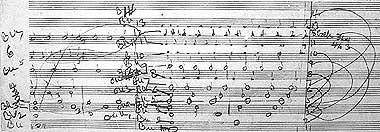
An Ives sketch for his Universe Symphony |
Lambert relates Ives's vision to the development of cosmology from Plato to Scriabin, noting the superiority of music over literature to depict spirituality directly rather than through linguistic metaphor. Stuart Feder, on the other hand, views it more skeptically as evidence of Ives's mental dysfunction and ebbing creative impulse.
Ives's own heady goal: "The time is coming, but not in our lifetime, when music will develop possibilities inconceivable now – a language so transcendent that its heights and depths will be common to all mankind." He left 34 pages of sketches of partially-completed fragments, graphic outlines and narrative that range from relative clarity to utter bafflement. The structure comprises three fundamental sections denoted as Formation and Chaos, Earth, and Heaven or Spirit, plus at least one prelude (and possibly two more). The instrumental forces are to be divided into three fundamental parts – upper (five groups of chordal counterpart), middle (18 different lines of percussion) and lower (five more orchestras). Lambert describes the only clearly identified prelude, which Ives called "the pulse of the universe," as layering 19 percussion instruments and a piccolo to subdivide eight-second basic pulses into equal metric units of 2, 3, 4, 5, 6, 7, 8, 9, 10, 11, 12, 13, 14, 17, 19, 22, 23, 29 and 31 beats, and which accumulate and recede in ten cycles that include varying degrees of variation and improvisation. From there, things get even more sketchy and thus speculative.
While the Fourth Symphony may have been the forebear of the Universe by sheer virtue of its scope, Ives had provided a more direct model in his astoundingly prescient 1906 Unanswered Question,

The trumpet's repeated "question" |
which achieves remarkable philosophical depth through extreme musical efficiency. Bernstein hailed it as naïve yet profound. Over a soft, constant, sweetly tonal string background, a solo trumpet patiently and persistently intones a short, searching phrase. After each of the first five iterations of the "question," a quartet of flutes, presumably representing the progress of our society and evolution of our thinking, intones increasingly complex and frantic responses, leaving the final question to trail off into the strings' cosmos, wholly indifferent to human striving and utterly unaffected by our brief, insignificant existence. Ives just may have said more with a handful of instruments in a few haunting minutes than Wagner could manage with a force of hundreds in a day's worth of rambling text and orchestral bombast. Lambert asserts that Ives "had already asked the Unanswered Question; with the Universe Symphony he aspired to answer it."
According to his biographers Henry and Sidney Cowell, Ives may have planned from the outset to leave the Universe Symphony unfinished, "as it represents aspects of life about which there is always something more to be said. [Ives's conception was] so gigantic, so inclusive and so exalted that he feels its complete realization is beyond any single man and so has invited collaboration." 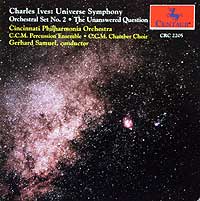 The first composer to have risen to that formidable challenge was Larry Austin, who spent twenty years assembling a "realization." A word of caution, though – in order to ensure the accuracy of the complex percussion rhythms, Austin fed click tracks (the electronic equivalent of a metronome) to the players through headphones. Admittedly, while Ives claimed to have been able to imagine five or six simultaneous rhythms at once, keeping accurate interlaced beats of, say, 11, 17 and 23 seems beyond the ability of even the most experienced musician. Yet, as Eric Salzman observed, Ives meant his music primarily to be performed and only secondarily to be heard, and even then in an active, participatory way. Given his fascination with the human "errors" that naturally crept into even simple renditions of plain hymns, I'm not sure that Ives would have endorsed a mechanical method of ensuring perfect consistency and accuracy in playing his work, but rather might have reveled in the sheer challenge (and unpredictable results) of men and women armed with nothing more than ears, minds and bodies struggling to make the attempt. That said, Austin's result, as presented in a 1994 recording by the Cincinnati Philharmonic Orchestra, C.C.M. Percussion Ensemble and C.C.M Chamber Choir conducted by Gerhard Samuel and four assistants (Centaur CD) is fascinating, if far less interesting to hear than it would be to perform. Sounding more like sterile, disembodied electronic computer-generated music than anything organic, the first half is consumed by the percussion ensemble played over a deep, soft earth chord. While Ives's plans indicate that this work was to bear scant resemblance to any of his others – even the most radical – the result here seems rather arbitrary and random, and at only 37 minutes far too brief to fulfill the expectations aroused by the mammoth scope suggested by all his tantalizing sketches and visionary plans. The first composer to have risen to that formidable challenge was Larry Austin, who spent twenty years assembling a "realization." A word of caution, though – in order to ensure the accuracy of the complex percussion rhythms, Austin fed click tracks (the electronic equivalent of a metronome) to the players through headphones. Admittedly, while Ives claimed to have been able to imagine five or six simultaneous rhythms at once, keeping accurate interlaced beats of, say, 11, 17 and 23 seems beyond the ability of even the most experienced musician. Yet, as Eric Salzman observed, Ives meant his music primarily to be performed and only secondarily to be heard, and even then in an active, participatory way. Given his fascination with the human "errors" that naturally crept into even simple renditions of plain hymns, I'm not sure that Ives would have endorsed a mechanical method of ensuring perfect consistency and accuracy in playing his work, but rather might have reveled in the sheer challenge (and unpredictable results) of men and women armed with nothing more than ears, minds and bodies struggling to make the attempt. That said, Austin's result, as presented in a 1994 recording by the Cincinnati Philharmonic Orchestra, C.C.M. Percussion Ensemble and C.C.M Chamber Choir conducted by Gerhard Samuel and four assistants (Centaur CD) is fascinating, if far less interesting to hear than it would be to perform. Sounding more like sterile, disembodied electronic computer-generated music than anything organic, the first half is consumed by the percussion ensemble played over a deep, soft earth chord. While Ives's plans indicate that this work was to bear scant resemblance to any of his others – even the most radical – the result here seems rather arbitrary and random, and at only 37 minutes far too brief to fulfill the expectations aroused by the mammoth scope suggested by all his tantalizing sketches and visionary plans.
A second realization by Johnny Reinhart (played by the American Festival of Microtonal Music Orchestra on a 2007 Stereo Society CD) is nearly twice as long, but it, too, shrinks from the experience of a live performance with multitracking and (to me, at least) also falls short of the experience suggested by Ives's sweeping intentions. 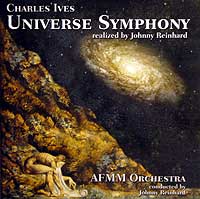 In his notes, Reinhart knocks Austin's as "more an original work of a different composer, who uses elements of Ives's imagination as grist for his compositional mill" and considers his own approach to be that of "a curator, an arbiter who accepted Ives' (very detailed) instructions at face value. My actual contributions to the score are far less than those implied by the wealth of information furnished by a great composer desperate to have his piece finished because he was lacking the necessary physical strength to accomplish the task himself." The results are strikingly different – for the first prelude, Reinhart uses a 16-second basic pulse, divided into 2, 3, 4, 5, 6, 7, 8, 9, 10, 11, 12, 13, 14, 15, 16, 17, 19, 21, 23, 29, 31, 37, 41 and 43 beats, quarter-tones, Pythagorean tuning (rather than equal temperament, resulting in far different enharmonic notes – thus, C-sharp is an eighth-tone higher than D-flat) for "greater consonance and richer dissonance" and such unusual "instruments" as a marble slab and a pail dropped into a wooden box. Call me Rollo, but (with apologies to Ives) it's a lot harder on the ears than the Austin version and, even after embracing most of Ives's extreme work, tests my patience. (And, yes, I recognize the hypocrisy of saying that after smugly disparaging critics who dumped on Ives's challenging music.) In his notes, Reinhart knocks Austin's as "more an original work of a different composer, who uses elements of Ives's imagination as grist for his compositional mill" and considers his own approach to be that of "a curator, an arbiter who accepted Ives' (very detailed) instructions at face value. My actual contributions to the score are far less than those implied by the wealth of information furnished by a great composer desperate to have his piece finished because he was lacking the necessary physical strength to accomplish the task himself." The results are strikingly different – for the first prelude, Reinhart uses a 16-second basic pulse, divided into 2, 3, 4, 5, 6, 7, 8, 9, 10, 11, 12, 13, 14, 15, 16, 17, 19, 21, 23, 29, 31, 37, 41 and 43 beats, quarter-tones, Pythagorean tuning (rather than equal temperament, resulting in far different enharmonic notes – thus, C-sharp is an eighth-tone higher than D-flat) for "greater consonance and richer dissonance" and such unusual "instruments" as a marble slab and a pail dropped into a wooden box. Call me Rollo, but (with apologies to Ives) it's a lot harder on the ears than the Austin version and, even after embracing most of Ives's extreme work, tests my patience. (And, yes, I recognize the hypocrisy of saying that after smugly disparaging critics who dumped on Ives's challenging music.)
Perhaps my problem with both "realizations" is that Ives, as bold and eclectic a composer who ever lived, never moved the Universe beyond a largely abstract level, and so any effort to cast it into concrete, tangible form must necessarily pale in comparison to the vast implications of his boundless conception. Thus, although these two realizations are intriguing and hopefully will inspire others, perhaps their greatest value lies not in successfully completing Ives's final work, but rather in prompting us to contemplate the extraordinary scope of Ives's imagination, to acknowledge that his vision vastly exceeded the grasp of mere mortals and even himself, to view his art as an invitation to exercise our own thoughts, to appreciate the extraordinary extent to which he was able to fit manageable portions of his insight into his finished works, and to listen to them with ears receptive to the even greater things they were meant to represent.
 Ives appears to have never conducted any of his work, so we have only indirect hints as to his performance expectations. Perhaps out of sheer gratitude for their bold initiative, he offered no criticism of the few, mostly obscure, conductors and fellow avant-garde composers who occasionally programmed his pieces. Yet we do have some clues.
Ives appears to have never conducted any of his work, so we have only indirect hints as to his performance expectations. Perhaps out of sheer gratitude for their bold initiative, he offered no criticism of the few, mostly obscure, conductors and fellow avant-garde composers who occasionally programmed his pieces. Yet we do have some clues.
Ives had no patience for professors, critics or audiences who barely tolerated or even ridiculed his work. Ives shot right back, calling them "lilies … whose ears and brains are somewhat emasculated from disuse," writing about things which they didn't know and didn't try to know and thus getting money under false pretenses. 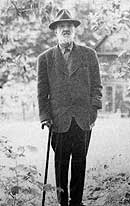 "[T]hese commercial pansies are either stupid or they are liars." Ives took particular offense at a critic who had claimed that his music had been influenced by Paul Hindemith "who really didn't start to compose until … several years after I had completed all of my (good or bad) music." Ives concluded that the critic was "either musically unintelligent or deliberately unfair. To say it quickly, he is either a fool or a crook." "[T]hese commercial pansies are either stupid or they are liars." Ives took particular offense at a critic who had claimed that his music had been influenced by Paul Hindemith "who really didn't start to compose until … several years after I had completed all of my (good or bad) music." Ives concluded that the critic was "either musically unintelligent or deliberately unfair. To say it quickly, he is either a fool or a crook."
The same attitude colored his view of teachers and performers. He accused the former of stifling musical evolution by teaching student composers to "manufacture conventionalized mush." As for performers, he recalled that his father "would always encourage the people to sing their own way. … If they threw the poet or the composer around a bit, so much the better for the poetry and the music. … There was power and exaltation in these great conclaves of sound from humanity. I've heard the same hymns played by nice celebrated organists and sung by highly-known singers in beautifully upholstered churches, and in the process everything in the music was emasculated … . They take a mountain and make a sponge cake [out] of it."
Kirkpatrick recalled in 1970 that his attempts to get the composer's advice during his struggles to master the Concord were unavailing, as Ives never gave him a chance to play. Rather, according to Kirkpatrick, Ives invited his performers to take some part in the formulation of the music as it went along, and expected them to improvise certain aspects of the texture, just as he himself would do, giving the performer "carte blanche to do anything he wanted. His supposition was that if your heart was in the right place, and if you were really devoted in an idealistic way to the music, anything you did would have a certain validity, comparable to the validity of what he himself would do in the situation." Even so, Arthur Berger noted that spontaneity was to have its limits, as Ives did expect performers to play the notes as written (and, indeed, some of Ives's scores are scrupulously detailed with complex metrical and dynamic notation and marginal directions).
Even more significant than Ives's words or others' thoughts are 78 minutes of piano recordings Ives made in four sessions from 1934 to 1944 (now compiled on a New World CD). A steep challenge for those with Rollo or Ladybird tendencies, they provide an untamed but direct glimpse into the messy Ives workshop. Never intended for public consumption, the informal sessions, held long after Ives' retirement, were undertaken primarily for a far more poignant reason – he just wanted to hear how his music sounded – and to provide guidance to (then largely non-existent, but hoped-for future) performers. So, with typical Yankee resolve, Ives decided to record some of it himself. Nearly all the cuts are studies and embellishments of the "Emerson" movement of his Concord Sonata, with which Ives remained obsessed long after his creative period ended. Ives clearly loved this music and (to the horror of would-be performers) bridled at the notion of a definitive edition, constantly rewriting it with evolving insight, reveling in "the daily pleasure of playing this music and seeing it grow, and feeling that it is not finished and the hope that it will never be." 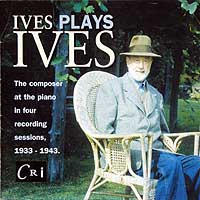 His approach is raw and spontaneous, and therefore as close to documenting in sound the core of his outlook as we can ever hope to come. Ives even lustily bellows his song, "They Are There" – nominally a patriotic World War II march to rouse our troops, but with some decidedly quirky sentiments ("And the people, not just politicians, / Will rule their own lands and lives / And you'll hear the whole universe / Shouting the battle cry of freedom … "). His father once told him, "Don't pay too much attention to the sounds or you may miss the music." And sure enough, although Ives's vocals are crude, off-key, and glaringly unmusical (in every conventional sense), the indomitable spirit of his song comes barreling through. His approach is raw and spontaneous, and therefore as close to documenting in sound the core of his outlook as we can ever hope to come. Ives even lustily bellows his song, "They Are There" – nominally a patriotic World War II march to rouse our troops, but with some decidedly quirky sentiments ("And the people, not just politicians, / Will rule their own lands and lives / And you'll hear the whole universe / Shouting the battle cry of freedom … "). His father once told him, "Don't pay too much attention to the sounds or you may miss the music." And sure enough, although Ives's vocals are crude, off-key, and glaringly unmusical (in every conventional sense), the indomitable spirit of his song comes barreling through.
And yet, there was another, rather surprising, side to the crusty, impulsive composer. After 73 minutes of such challenging, improvisational stuff, the final side wraps up on a breathtaking but baffling note – an exquisitely sensitive rendition of the serene "Alcott" movement of the Concord Sonata that is as gorgeous, intimate and inviting as the rest is thorny, bewildering and alienating. This simplest, most appealing music Ives ever wrote lifts its theme from the famous opening "fate" motif of Beethoven's Fifth (which Ives called "the soul of humanity knocking at the door of the divine mysteries, radiant in the faith that it will be opened, and the human become the divine!"), adds a wistful tail and yields a firmly tonal result spiced with searching distant harmonies, strong and bold but with tender, honest emotion. Although Ives's playing adheres rather closely to the printed score, he adds considerable rhythmic freedom and phrasing plasticity; the Kirkpatrick recording, widely acclaimed for its presumed authenticity, is far more literal in comparison. Both the piece and Ives' performance are a disarming yet deeply moving distillation of his genius – short and direct, nothing wasted, planting a clichéd German theme into the rich Connecticut soil from which it springs up afresh, transforming the formulas of the past into a wholly new music of shimmering vision. It's nothing less than a microcosm of our national history, in which our forefathers crafted their immigrant traditions into a new revolutionary spirit, aglow with confidence in the promise of a boundless future. But I digress (although that hardly seems inappropriate when speaking of Ives) …
 In light of what we can infer from Ives' own words and playing, it would seem a gross violation of his spirit to apply to others' recordings of his work the usual criteria of technical precision, sonic quality or, least of all, notions of idiomatic interpretation. Rather, the only valid measure would seem to be far less tangible – the sincere commitment, enthusiasm and spirit of the performance. For that, I most often turn to the pioneers who strode bravely forward in an era, not so long ago, when advocating Ives was a lonely and unrewarding mission upon which only the most intrepid would dare embark.
In light of what we can infer from Ives' own words and playing, it would seem a gross violation of his spirit to apply to others' recordings of his work the usual criteria of technical precision, sonic quality or, least of all, notions of idiomatic interpretation. Rather, the only valid measure would seem to be far less tangible – the sincere commitment, enthusiasm and spirit of the performance. For that, I most often turn to the pioneers who strode bravely forward in an era, not so long ago, when advocating Ives was a lonely and unrewarding mission upon which only the most intrepid would dare embark.
So … with all of that in mind, let's consider the available recordings of the Ives Fourth Symphony:
- Leopold Stokowski, American Symphony Orchestra, Schola Cantorum of New York (1965, Columbia LP, Masterworks Portrait CD) —
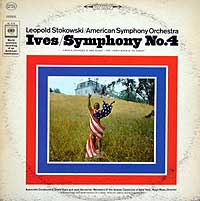 Recorded three days after these very forces gave the world premiere concert of the entire work, this remains a towering achievement, fully meriting the critical accolades it received at the time. Thus, Miles Kastendieck in the New York Journal-American proclaimed: "Ives's individualism abounds in philosophical and religious overtones … . Life has its moments of chaos as well as order. Such is the revelation of [this] symphony. … Above everything towered Mr. Stokowski, as individual a conductor as Ives a composer. His creative spark kindled the orchestra to spirited performance." Founded in 1962 by Stokowski (then age 80), the American Symphony Orchestra had not yet jelled into a well-oiled machine, and its elemental grittiness preserves the sense of a daring venture, peering around corners to seek discoveries amid dimly-lit terrain. Most tempo changes are slighted (even though Ives was scrupulous in his specifications, with 21 tempo directions in the first movement alone) and, perhaps to accommodate the inherent ambient noise of analog taping, dynamics are tempered. While Stokowski can't resist spotlighting solo turns and events along the way (including a vastly exaggerated quarter-tone wedge at 9:15 in the second movement), for me this just adds a sense of the performers' sheer pride in bringing the work to triumphant fruition, and helps listeners to navigate among all the concurrent activity. If Stokowski's light occasionally shines too glaringly bright, it is only to delight in illuminating previously unseen splendor. My personal touchstone for any recording of the Fourth is the opening, and Stokowski's forces hit it just right, with rough, unpolished vigor, utterly and unapologetically shorn of refinement. This brash, intensely vital recording, edgily balanced between tentative exploration and fearless impulsion, seems just the way Ives would have wanted it, Ladybirds be damned. Recorded three days after these very forces gave the world premiere concert of the entire work, this remains a towering achievement, fully meriting the critical accolades it received at the time. Thus, Miles Kastendieck in the New York Journal-American proclaimed: "Ives's individualism abounds in philosophical and religious overtones … . Life has its moments of chaos as well as order. Such is the revelation of [this] symphony. … Above everything towered Mr. Stokowski, as individual a conductor as Ives a composer. His creative spark kindled the orchestra to spirited performance." Founded in 1962 by Stokowski (then age 80), the American Symphony Orchestra had not yet jelled into a well-oiled machine, and its elemental grittiness preserves the sense of a daring venture, peering around corners to seek discoveries amid dimly-lit terrain. Most tempo changes are slighted (even though Ives was scrupulous in his specifications, with 21 tempo directions in the first movement alone) and, perhaps to accommodate the inherent ambient noise of analog taping, dynamics are tempered. While Stokowski can't resist spotlighting solo turns and events along the way (including a vastly exaggerated quarter-tone wedge at 9:15 in the second movement), for me this just adds a sense of the performers' sheer pride in bringing the work to triumphant fruition, and helps listeners to navigate among all the concurrent activity. If Stokowski's light occasionally shines too glaringly bright, it is only to delight in illuminating previously unseen splendor. My personal touchstone for any recording of the Fourth is the opening, and Stokowski's forces hit it just right, with rough, unpolished vigor, utterly and unapologetically shorn of refinement. This brash, intensely vital recording, edgily balanced between tentative exploration and fearless impulsion, seems just the way Ives would have wanted it, Ladybirds be damned.
- Harold Farberman, New Philharmonia Orchestra, Ambrosian Singers (1967, Vanguard Cardinal LP) — The next Fourth came from an unlikely source. Although largely overlooked nowadays, Harold Farberman, an American percussionist (the Boston Symphony's youngest member) turned composer, conductor and teacher, recorded not only the second Fourth but the first integral set of the Ives numbered symphonies, an achievement not matched until over two decades later.
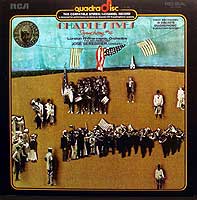 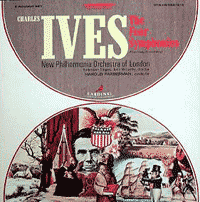 (Most conductors tend to be highly selective – even Bernstein, Ives's foremost champion, only played the Second, Third and Holidays.) Farberman's Fourth is rather straight-forward and, except for a swift opening movement with loud, assertive vocals and an abrupt, perfunctory closing, gains a sense of atmospheric expectancy through deliberate pacing, running nearly five minutes longer than Stokowski. The third movement is especially moving, with a feeling of sweet innocence. Well-played, attentive and generally satisfying, it deserves far more recognition than it has received. (Most conductors tend to be highly selective – even Bernstein, Ives's foremost champion, only played the Second, Third and Holidays.) Farberman's Fourth is rather straight-forward and, except for a swift opening movement with loud, assertive vocals and an abrupt, perfunctory closing, gains a sense of atmospheric expectancy through deliberate pacing, running nearly five minutes longer than Stokowski. The third movement is especially moving, with a feeling of sweet innocence. Well-played, attentive and generally satisfying, it deserves far more recognition than it has received.
- José Serebrier, London Philharmonic Orchestra, John Alldis Choir (1974, RCA LP and High Performance CD) — This recording is a close relative to Stokowski's, as Serebrier had served as associate conductor of the American Symphony and at the premiere of the Fourth literally had sat at the side of his mentor, who praised him as "the greatest master of orchestral balance." Thus, on his own a decade later to celebrate the composer's centennial, it is hardly surprising that Serebrier, too, brings his soloists to the forefront, and to such an extent that a lone cello, marked pianissimo in the prelude introduction, overpowers the massed strings. Yet generally his ensemble is more fully blended, although the original quadraphonic LP release may have helped to clarify the textures more than is evident in the present stereo mix, and his dynamics are more pronounced, generating considerable suspense prior to the second movement outbursts and enabling the first and fourth movements to subside into exquisitely hushed inner spaces. After a thrillingly swift celebration to close the comedy, his remaining tempos are more leisurely than Stokowski's, with an especially colorfully-textured fugue.
- Seiji Ozawa, Boston Symphony, Tanglewood Festival Chorus (1977, DG) — The next recording came from another young conductor with Ives credentials. Ozawa trained as Bernstein's assistant and had recorded Ives's Central Park in the Dark ("under the supervision of Mr. Bernstein," according to the album) as a filler on Bernstein's Columbia LP of the Ives Third Symphony). His timings track Stokowski's (and his 2'50" prelude is the fastest on record),
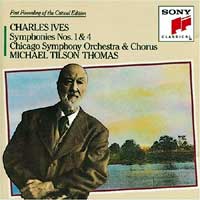 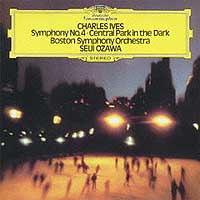 the playing is precise and the recording is finely detailed, but he generally polishes all the rough edges to a fine sheen, and thereby loses much of the work's essence. For me, much of the battle is lost at the outset when that rude trumpet fanfare is barely heard. While the comedy seems disengaged and rather randomly thrown together, this rather methodical approach works better in the second half of the work – the steady fugue provides patient relief from the frantic activity that precedes it (and that "Joy to the World" trombone phrase slides by rather than sticking out incongruously), and the finale lets its events unfold, build and subside in a way that suggests an organic process rather than an overwhelming incursion, even though the ending is too abrupt to complete the effect. Overall, while perhaps the least idiomatic of the Fourth recordings, Ozawa's subtlety demonstrates another layer of meaning in this exceedingly complex work. the playing is precise and the recording is finely detailed, but he generally polishes all the rough edges to a fine sheen, and thereby loses much of the work's essence. For me, much of the battle is lost at the outset when that rude trumpet fanfare is barely heard. While the comedy seems disengaged and rather randomly thrown together, this rather methodical approach works better in the second half of the work – the steady fugue provides patient relief from the frantic activity that precedes it (and that "Joy to the World" trombone phrase slides by rather than sticking out incongruously), and the finale lets its events unfold, build and subside in a way that suggests an organic process rather than an overwhelming incursion, even though the ending is too abrupt to complete the effect. Overall, while perhaps the least idiomatic of the Fourth recordings, Ozawa's subtlety demonstrates another layer of meaning in this exceedingly complex work.
- Michael Tilson Thomas, Chicago Symphony Orchestra and Chorus (1989, Sony CD) — 1989 brought two important developments. The first was completion of a new critical edition of the Fourth score by the Charles Ives Society. While the editors saluted the massive efforts involved in the publication of the second movement in 1929 and the rest in 1965, their revisions reflected 13 years of further wrestling with Ives's scattered and often obscure sketches, revisions and other source materials in an effort to glean his final intentions. Frankly, some of the changes seem inconsequential – unlike in tonal music, what's the harm in a few "wrong" notes for a composer who enjoyed them, and especially within the extreme density of such a capricious work? Of more practical importance was Tilson Thomas's recording, the first to be based on the new edition, which represents a significant further level of performance, transcending the bold (and necessary) pioneers' explorations to present the work in a more reflective light. Having worked with the editors to resolve performance problems, Tilson Thomas lavishes an unparalleled degree of care that shapes every phrase and radiates affection without compromising the essential nature of the work. Thus, the final note of the opening movement wondrously lingers and then dissolves over a full half-minute, the fugue is deeply reverential and heartfelt, and the finale, stretched to a luxuriant 10½ minutes, unfolds patiently with a swell of religious fervor amid searching contemplation. But perhaps the greatest revelation is the comedy, played with enormous atmosphere and feeling, at times seeming downright romantic, its layers impressing with a sense of logical construction and rational progression so that even its loudest, most complex portions avoid any sense of sounding like random noise. As a fine bonus, the CD includes performances of not only the Ives First but five of Ives's favorite (and oft-quoted) hymns.
- Christoph von Dohnányi, Cleveland Orchestra and Chorus (1992, Decca CD) — Much of the character of this reading flows from its orchestra, honed by George Szell for precision and polish in the mainstream repertoire. The cool, effortless clarity is evident from the unified opening chords and continues through the shifting textures of the comedy, where it helps us to discern the multiple layers of borrowings amid the myriad events, which are presented as startling and isolated brass-fueled dramatic episodes rather than blended into an overall sonic fabric, somewhat reminiscent of the Stokowski recording.
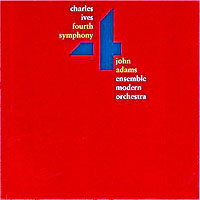 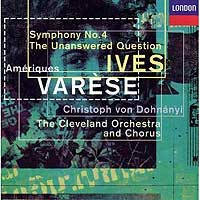 The fugue is right up the Cleveland's alley, its controlled aura subtly reaching beyond the deceptively plain music, but the finale benefits less from such an objective approach, emerging as more cold and mechanical than awe-inspiring. All the elements are there, but I prefer readings with more energy and spirit. The fugue is right up the Cleveland's alley, its controlled aura subtly reaching beyond the deceptively plain music, but the finale benefits less from such an objective approach, emerging as more cold and mechanical than awe-inspiring. All the elements are there, but I prefer readings with more energy and spirit.
- John Adams, Ensemble Modern Orchestra, Collegium Vocale Gent (EMCD, 1999) – If, as the saying goes, it takes one to know one, then this is a uniquely intriguing prospect – the Ives Fourth led by one of the foremost serious composers of our time (and who rarely leads any but his own work). Like Ives, John Adams was born and raised in New England, was taught by his father, bridled against the conservative outlook of his Ivy League professors, and was torn between modernism and tradition. That conflict led him to minimalism, which seems reflected in the crisp detail and thin textures of this concert performance. The overriding sonority is of chamber music, as might be expected from the 18-member self-governed, multicultural, Frankfort-based Ensemble Modern, even though that core group is expanded to full orchestral proportions. The softer portions display a compelling intimacy and focus, tempos are swift, and the fugue emerges as winningly casual, but the overall approach forfeits the heft and misses the atmosphere and sense of sheer wonder presented by others. Both piano and chorus tend to overwhelm the rest of the players, and the ending is abrupt. And while the cost may pale compared to a seat at the opera (or a football game, for that matter), 13 euros plus shipping for less than a half-hour of music is hard to justify.
- Andrew Litton, Dallas Symphony Orchestra and Chorus (2006, Hyperion CD and SACD) —
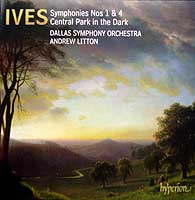 With this latest recording of the Ives Fourth we reach a new crossroads, although not necessarily a pinnacle. Here is Ives's most challenging work conveyed effectively by other than a top-tier orchestra led by a superstar conductor on a major label. Yet perhaps this is the ultimate sign that Ives at last has "arrived." Nicely played but without any particular character, and with tempered dynamics, a rich acoustic and a rather bland finale, this is not intrinsically idiomatic Ives, but rather attains a new level of maturity, at least according to the standards often applied to interpretation of the standard repertoire. Does this herald the day when Ives's Fourth will be routinely included in concert programs? Probably not – the extensive rehearsals mandated by its complexity recalls Ives's admonition that "Money may travel faster than the speed of sound in some directions, but not in direction of musical experimentation or extension." Yet, the day may be edging nearer when Ives will no longer be viewed as a cultural outcast, and performances of his work as an extraordinary occasion, but rather when he will take his place comfortably in the continuum of mainstream American music. And perhaps that would be the ultimate tribute to his intrinsic value, the fulfillment of his deepest aspirations and a development which Ives himself never would have foreseen yet privately just might have welcomed. With this latest recording of the Ives Fourth we reach a new crossroads, although not necessarily a pinnacle. Here is Ives's most challenging work conveyed effectively by other than a top-tier orchestra led by a superstar conductor on a major label. Yet perhaps this is the ultimate sign that Ives at last has "arrived." Nicely played but without any particular character, and with tempered dynamics, a rich acoustic and a rather bland finale, this is not intrinsically idiomatic Ives, but rather attains a new level of maturity, at least according to the standards often applied to interpretation of the standard repertoire. Does this herald the day when Ives's Fourth will be routinely included in concert programs? Probably not – the extensive rehearsals mandated by its complexity recalls Ives's admonition that "Money may travel faster than the speed of sound in some directions, but not in direction of musical experimentation or extension." Yet, the day may be edging nearer when Ives will no longer be viewed as a cultural outcast, and performances of his work as an extraordinary occasion, but rather when he will take his place comfortably in the continuum of mainstream American music. And perhaps that would be the ultimate tribute to his intrinsic value, the fulfillment of his deepest aspirations and a development which Ives himself never would have foreseen yet privately just might have welcomed.
 |
 Although he received minimal appreciation or recognition during his life, Ives has inspired an astounding extent and variety of scholarship in the mere half-century or so since his death. More than any other sign, this amply attests to the extraordinary rise in the esteem in which he has come to be held.
Although he received minimal appreciation or recognition during his life, Ives has inspired an astounding extent and variety of scholarship in the mere half-century or so since his death. More than any other sign, this amply attests to the extraordinary rise in the esteem in which he has come to be held.
- Of primary importance are Ives's own writings. (Kirkpatrick likens Ives's writing to his music: "The ideas tumble in on one another and they make a kind of magnificent soaring ascent.")
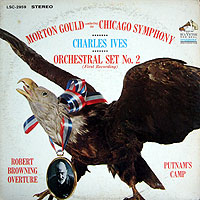
- Essays Before a Sonata and Other Writings (edited and annotated by Howard Boatwright, Norton, 1961). This collection comprises Ives's only (and originally self-) published work. Ives's quirky ramblings are full of quotable quotes (including most of the ones I've cited above) – especially the "Epilogue" to the Essays Before a Sonata and the Postface to 114 Songs.
- Charles E. Ives: Memos (edited and annotated by John Kirkpatrick, Norton, 1991). In the early 1930s Ives dictated memoirs, to which Kirkpatrick added illuminating letters and background material. (Annotation of Ives's writings is essential, since so many of his references to initials, nicknames and now-forgotten people, places and events are otherwise obscure.)
- Vivian Perlis: Charles Ives Remembered – An Oral History (Yale University, 1974) is a useful and enlightening supplement, presenting the recollections of those who knew Ives from boyhood to old age and who immeasurably enrich – and occasionally contradict – Ives's own reminiscences. Among the most valuable are interviews with Elliott Carter, Bernard Hermann and John Kirkpatrick.
- Biographies and Other Studies
- Henry and Sidney Cowell: Charles Ives and His Music (Oxford University Press, 1955) - Despite all the valuable modern scholarship and analysis, in many ways this first book about Ives remains unique – a deeply insightful yet objective appreciation by a fellow composer, who was Ives' foremost advocate, and his ethnomusicologist wife, who grew close to the Iveses.
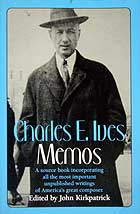 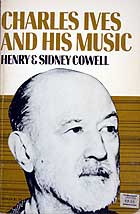 Enriched by interviews with acquaintances (there were few colleagues) and completed only four days before Ives's death, it's short and accessible and gives an unparalleled vibrant portrait of its unique subject. Enriched by interviews with acquaintances (there were few colleagues) and completed only four days before Ives's death, it's short and accessible and gives an unparalleled vibrant portrait of its unique subject.
- Frank R. Rossiter: Charles Ives and His America (Liveright, 1975) was one of the first of an amazing number of more detailed biographies and studies that benefit from research amid the composer's horrendously chaotic relics, and helps to place Ives's life and work in the context of his society.
- Jan Swafford: Charles Ives – A Life With Music (Norton, 1996) deflates some of the myths surrounding the Ives legend, treats the composer as a unique human being, and elucidates his music, including a brilliant chapter that illuminates the Fourth Symphony, while thoughtfully reserving technical analysis to extensive footnotes.
- Philip Lambert: The Music of Charles Ives (Yale University, 1997) - Speaking of which, while much of Lambert's analyses are way over my head, he presents detailed dissection of several pieces and Ives's methods, including an intriguing in-depth look at the Universe manuscripts.
- Ives Studies (ed: Philip Lambert, Cambridge University, 1997) contains two chapters that are devoted to Lambert's relation of the Universe Symphony to cosmological precedent and Larry Austin's detailed justification of his realization, including fascinating reproductions of sixteen of Ives's autograph pages for his final baffling conception.
- Charles Ives and the Classical Tradition (ed: Geoffrey Block and J. Peter Burkholder, Yale University, 1996) places Ives in the 19th century tradition and contrasts his work with European counterparts.
- Charles Ives and His World (ed: J. Peter Burkholder, Princeton University, 1996) provides many valuable documents and reviews.
- Gayle Sherwood Magee: Charles Ives Reconsidered (University of Illinois, 2008) presents a more critical and often cynical look at the Ives legend.
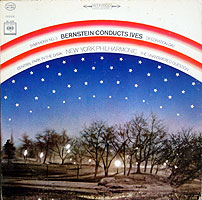
- Scores — Especially essential, if you can find a copy, is the oversized published score of the Fourth Symphony (Associated Music Publishers, 1965). (The District of Columbia Public Library has one in its amazingly comprehensive trove of all things musical.) Not only does it contain Kirkpatrick's informative introduction that traces the chronology and catalogs the borrowings, but also Ives's own fascinating and highly diffuse conductor's note to the second movement. Plus, merely seeing the array of notes on the page helps to drive home the breadth of the composer's vision.
- Finally, the most comprehensive source for all things Ivesian is the Charles Ives Society website (www.charlesives.org), an astoundingly detailed compendium of facts, listing for each of his 399 completed works (and 300+ fragmentary, lost and projected ones) score excerpts, source materials, information on drafts, publications, premieres and recordings, references to citations in literature, and informative commentary – perhaps far more detail than most of us think we might ever need, but enough to ensure that Ives scholars are left with relatively few "unanswered questions."

Copyright 2011 by Peter Gutmann
|

